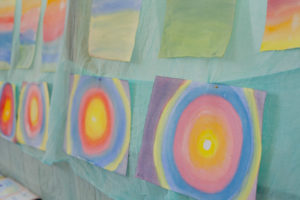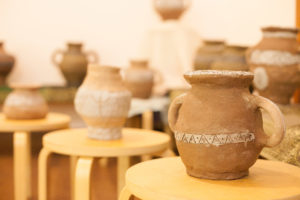PICTORIAL ARTS AND MODELLING PROGRAM AT RAINBOW RIDGE SCHOOL
“WATERCOLOUR IS LIKE LIFE”
Watercolours are transparent. Everything flows, painting with water colours. Because water colour actually moves on the paper, it is the most active of all painting media, almost a performing art or a dance. It is well suited to capturing mood.
Painting with water colours is practised mostly once per week with the class teacher. Rudolf Steiner based his indications for a painting curriculum on Goethe’s Theory of Colour and this approach forms an important part of Steiner teacher training.
The beginning of painting is purely out of the colours, which create moods that which could be described, for example as: quiet and retiring; strong and bold; cold and hard; warm and expansive. The outer picture is an expression of the inner experience. These experiences can be prepared through ‘painting stories’ or poetry or stories from the Main lessons. When the forms arise out of the colours, and we watch what happens on the paper and we think out of the colours the soul of the children is nourished. Throughout the Primary classes there are unending possibilities to explore colour moods and relationships and finding shapes out of colour.
In the Middle School a new technique, veil painting is introduced. This technique provides many new possibilities for achieving differentiation and depth of colour. In this Patience and endurance is practised, while the students have to wait for every layer to dry before they keep painting. They are required to while they have to use the colours very delicately and sensitively in a more pale application, to build up the depth. The range of media is widened to wet on dry paper painting, and using watercolour pencils to develop knowledge of colour and depth of soul experiences.
In Drawing the children experience a quality of movement and learn to understand the form gestures.
Dynamic Form Drawing is the first lesson children will experience when they start in class one. So initially the purpose of form drawing is to awaken the children’s sense of form. This is needed and used when they learn to write and read. If children have learnt to orientate by means of movement in the classroom as well as on paper, this can help later with spatial problems that might arise for those who are dyslexic. Such children derive a good deal of assistance help from the therapeutic possibilities of form drawing.
When geometry begins in class 5, form drawing is absorbed into geometric drawing. By class 6 the children have reached ‘the age of causality’ which calls for real accuracy in their drawing. At the same time they also embark on a new kind of artistic drawing, namely drawing with charcoal. This drawing then leads on to projection and shadows.
As well Drawing is also utilised used in other lessons to support the themes of these lessons. The drawing is introduced to create colour areas (not sharp outlines) with wide wax block crayons. As the children grow the drawing instruments change to oil chalks and coloured pencils, and in class 6 they’ll do black and white exercises with charcoal and conte.
Drawing is not taught as a separate lesson but integrated by the class teachers into their Main Subject Lessons.

MODELLING AND SCULPTURE
Modelling is developed from the whole and moves to the parts. It is not a matter of adding bits of clay or plasticine here and there, rather working with the whole lump, a given amount that can be shaped and changed. Pressure and counter pressure shape the form of the surfaces, thus the hands become a kind of organ of perception. In modelling, the underlying principle is that of the metamorphosis of the form. That which is given, -the material, – is transformed through the activity of the soul, in a process that reflects the inner metamorphosis that comes to expression through child development. When the children are fully engaged in the task of modelling, they are usually quiet, concentrated, breathing deeply and unaware of their surroundings.
Wherever appropriate during classes 1 to 3 the class teacher will let guide the children to model with clay, beeswax or plasticine. From class 4 onwards simple solids, animal forms, growth forms and shapes of various types of mountains are explored through modelling.
All these artistic activities are part of all learning.




